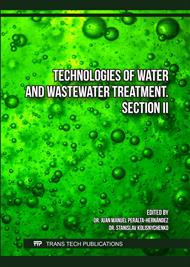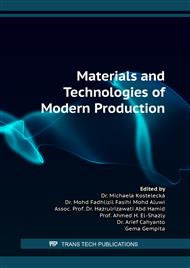[1]
Information on https://www.sinarharian.com.my/article/990/EDISI/Kelantan/AKSB-diiktiraf-Malaysia-Book-of-Records.
Google Scholar
[2]
SPAN (Suruhanjaya Perkhidmatan Air Negara), Annual Report, (2018) 30.
Google Scholar
[3]
F.R. Mohd Faiz, M. Noorazuan, Perubahan kualiti air bawah tanah di negeri Kelantan pada tahun 2010 hingga 2012, JWS. 2 (2018) 1-10.
Google Scholar
[4]
H.H. Hazimah, M.K. Mohamad Roslan, S. Nurhidayu, A. Zulfa Hanan, M.K. Faradiella, Hydrogeochemistry investigation on groundwater in Kuala Langat, Banting, Selangor, Bull. Geol. Soc. Malays. 67 (2019) 127-134.
Google Scholar
[5]
R. Muoio, C. Caretti, L. Rossi, D. Santianni, C. Lubello, Water safety plans and risk assessment: A novel procedure applied to treated water turbidity and gastrointestinal diseases C, Int J Hyg Environ Health. 223 (2020) 281-288.
DOI: 10.1016/j.ijheh.2019.07.008
Google Scholar
[6]
Information on https://www.who.int/water_sanitation_health/hygiene/emergencies/fs2_33.pdf.
Google Scholar
[7]
Information on http://kmam.moh.gov.my/public-user/drinking-water-quality-standard.html.
Google Scholar
[8]
G.S. Simate, S.E. Iyuke, S. Ndlovu, M. Heydenrych, L.F. Walubita, Human health effects of residual carbon nanotubes and traditional water treatment chemicals in drinking water, Environ. Int. 39 (2012) 38-49.
DOI: 10.1016/j.envint.2011.09.006
Google Scholar
[9]
M. Karnib, A. Kabbani, H. Holail, Z. Olama, Heavy metals removal using activated carbon, silica and silica activated carbon composite, Energy Procedia. 50 (2014) 113-120.
DOI: 10.1016/j.egypro.2014.06.014
Google Scholar
[10]
P. Meng, X. Fang, A. Maimaiti, G. Yu, S. Deng, Efficient removal of perfluorinated compounds from water using a regenerable magnetic activated carbon, Chemosphere. 224 (2019) 187-194.
DOI: 10.1016/j.chemosphere.2019.02.132
Google Scholar
[11]
D. Dermatas, T. Mpouras, N. Papassiopi, C. Mystrioti, A. Toli, I. Panagiotakis, Adsorption of groundwater pollutants by iron nanomaterials, in: M.I. Litter, N. Quici, M. Meichtry (Eds), Iron nanomaterials for water and soil treatment, Pan Stanford Publishing Pte. Ltd., Singapore, 2018 pp.37-55.
DOI: 10.1201/b22501-3
Google Scholar
[12]
C. Santhosh, A. Malathi, E. Dhaneshvar, A. Bhatnagar, A.N. Grace, J. Madhavan, Nanoscale materials in water purification, Elsevier Inc, Amsterdam, Netherlands. (2019).
DOI: 10.1016/b978-0-12-813926-4.00022-7
Google Scholar
[13]
P. Tancredi, L.S. Veiga, O. Garate, G. Ybarra, Magnetophoretic mobility of iron oxide nanoparticles stabilized by small carboxylate ligands, Colloids Surf. A. 579 (2019) 123664.
DOI: 10.1016/j.colsurfa.2019.123664
Google Scholar
[14]
A.L. Cazetta, O. Pezoti, K.C. Bedin, T.L. Silva, A. Paesano Junior, T. Asefa, V.C. Almeida, Magnetic activated carbon derived from biomass waste by concurrent synthesis: efficient adsorbent for toxic dyes, ACS Sustain Chem Eng. 4 (2016) 1058-1068.
DOI: 10.1021/acssuschemeng.5b01141
Google Scholar
[15]
W. Park, S. Jeong, S. Im, A. Jang, High turbidity water treatment by ceramic microfiltration membrane: Fouling identification and process optimization, Environ. Technol. Innov. 17 (2020) 100578.
DOI: 10.1016/j.eti.2019.100578
Google Scholar
[16]
P. Sannasi, A. Huda, B. Jayanthi, Synthesis of magnetic activated carbon treated with sodium dodecyl sulphate, Pertanika J. Sci. Technol. 29 (2021) 427-444.
Google Scholar
[17]
A. Nor Asfaliza, P. Sannasi, M.A. Mohamad Faiz, Modifying coconut shell biocarbon by base activation method using response surface modelling, ARPN J. Eng. Appl. Sci. 16 (2020) 1778-1783.
Google Scholar
[18]
R. Wannahari, P. Sannasi, M.F.M. Nordin, H. Mukhtar, Sugarcane bagasse derived nano magnetic adsorbent composite (SCB-NMAC) for removal of Cu2+ from aqueous solution, ARPN J. Eng. Appl. Sci. 13 (2018) 1-9.
Google Scholar
[19]
Information on http://osmindustrial.com/wp-content/uploads/2017/10/ASTM-D4607-Standard-Test-Method-for-Determination-of-Iodine-Number-of-Activated-Carbon.pdf.
Google Scholar
[20]
A. Mianowski, M. Owczarek, A. Marecka, Surface area of activated carbon determined by the iodine adsorption number, Energy Sources. 29 (2007) 839-850.
DOI: 10.1080/00908310500430901
Google Scholar
[21]
C.A. Nunes, M.C. Guerreiro, Estimation of surface area and pore volume of activated carbons by methylene blue and iodine numbers, Quim Nova. 34 (2011) 472-476.
DOI: 10.1590/s0100-40422011000300020
Google Scholar
[22]
T.A. Milne, H.L. Chum, F.A. Agblevor, D.K. Johnson, Standardized analytical methods biomass & bioenergy, Proceedings of International Energy Agency Bioenergy Agreement Seminar. 2 (1992) 341-366.
DOI: 10.1016/0961-9534(92)90109-4
Google Scholar
[23]
K.W.N. Wan Fatihah, C.S. Siti Kamila, A.R.A. Alyza Azzura, M.Y. Mohd Sukeri, S. Mustaffa, Synthesis and physicochemical properties of magnetite nanoparticles (Fe3O4) as potential solid support for homogeneous catalysts, Malays. J. Anal. Sci. 22 (2018) 768-774.
DOI: 10.17576/mjas-2018-2205-04
Google Scholar
[24]
S. Karthikeyan, P. Sivakumar, P.N. Palanisamy, Novel activated carbons from agricultural wastes and their characterization, E-J. Chem. 5 (2008) 409-426.
DOI: 10.1155/2008/902073
Google Scholar
[25]
A.F.G.H. Zulkarnia, A.S. Rezki, The potential of activated carbon derived from bio-char waste of bio-oil pyrolysis as adsorbent, MATEC Web of Conference. 01029 (2018) 1-6.
DOI: 10.1051/matecconf/201815401029
Google Scholar
[26]
X. Zhao, S. Yi, S. Dong, H. Xu, Y. Sun, X. Hu, Removal of Levofloxacin from aqueous solution by magnesium-impregnated biochar: Batch and column experiments, Chem. Speciat. Bioavailab. 30 (2018) 68-75.
DOI: 10.1080/09542299.2018.1487775
Google Scholar
[27]
A.R. Hidayu, N.F. Mohamad, S. Matali, A.S.A.K. Sharifah, Characterization of activated carbon prepared from oil palm empty fruit bunch using BET and FT-IR techniques, Procedia Eng. 68 (2013) 379-384.
DOI: 10.1016/j.proeng.2013.12.195
Google Scholar
[28]
S. Mopoung, P. Moonsri, W. Palsa, S. Khumpai, Characterization and properties of activated carbon prepared from tamarind seeds by KOH activation for Fe (III) adsorption from aqueous solution, Sci. World J. 2015 (2015) 415961.
DOI: 10.1155/2015/415961
Google Scholar
[29]
H. Sun, B. Yang, A. Li, Biomass derived porous carbon for efficient capture of carbon dioxide, organic contaminants and volatile iodine with exceptionally high uptake, Chem. Eng. J. 372 (2019) 65–73.
DOI: 10.1016/j.cej.2019.04.061
Google Scholar
[30]
Information on https://chem.libretexts.org/Ancillary_Materials/Reference/Reference_Tables/Spectroscopic_Parameters/Infrared_Spectroscopy_Absorption_Table.
Google Scholar
[31]
Information on https://www2.chemistry.msu.edu/faculty/reusch/virttxtjml/spectrpy/infrared/infrared.htm.
Google Scholar
[32]
A. Mirzaei, K. Janhorban, B. Hashemi, S.R. Hosseini, M. Bonyani, S.G. Leonardi, A. Bonavita, G. Neri, Synthesis and characterization of mesoporous α-Fe2O3 nanoparticles and investigation of electrical properties of fabricated thick films, Process. Appl. Ceram. 1 (2016) 209-217.
DOI: 10.2298/pac1604209m
Google Scholar
[33]
P. Suresh Kumar, T. Prot, L. Korving, K.J. Keesman, I. Dugulan, M.C.M. van Loosdrecht, G.J. Witkamp, Effect of pore size distribution on iron oxide coated granular activated carbons for phosphate adsorption – Importance of mesopores, Chem. Eng. J. 326 (2017) 231-239.
DOI: 10.1016/j.cej.2017.05.147
Google Scholar
[34]
C. Anyika, N.A.M. Asri, Z.A. Majid, A. Yahya, A. Jaafar, Synthesis and characterization of magnetic activated carbon developed from palm kernel shells, Nanotechnol. Environ. Eng. 2 (2017) 16.
DOI: 10.1007/s41204-017-0027-6
Google Scholar
[35]
N.D. Kandpal, N. Sah, R. Loshali, R. Joshi, J. Prasad, Co-precipitation method of synthesis and characterization of iron oxide nanoparticles, J. Sci. Ind. Res. 73 (2014) 87-90.
Google Scholar
[36]
S. Kim, J. Kim, G. Seo, Iron oxide nanoparticle-impregnated powder-activated carbon (IPAC) for NOM removal in MF membrane water treatment system, Desalination Water Treat. 51 (2013) 6392-6400.
DOI: 10.1080/19443994.2013.781000
Google Scholar
[37]
B. Shahmoradi, S. Yavari, Y. Zandsalimi, H.P. Shivaraju, M. Negahdari, A. Maleki, G. Mckay, R.P. Radheshyam, S.M. Lee, Optimization of solar degradation efficiency of bio-composting leachate using Nd: ZnO nanoparticles, J. Photochem. Photobiol. A. 356 (2018) 201-211.
DOI: 10.1016/j.jphotochem.2018.01.002
Google Scholar
[38]
S. Kumar, H. Meena, S. Chakraborty, B.C. Meikap, Application of response surface methodology (RSM) for optimization of leaching parameters for ash reduction from low-grade coal, Int. J. Min. Sci. Technol. 28 (2018) 621-629.
DOI: 10.1016/j.ijmst.2018.04.014
Google Scholar
[39]
A.U.F. Tezcan, N. Erginel, O. Ozcan, E. Oduncu, Adsorption of Disperse Orange 30 dye onto activated carbon derived from Holm Oak (Quercus Ilex) acorns: A 3k factorial design and analysis, J. Environ. Manage. 155 (2015) 89-96.
DOI: 10.1016/j.jenvman.2015.03.004
Google Scholar
[40]
R.H. Myers, D.C. Montgomery, C.M. Anderson-Cook, Response surface methodology, fourth ed., John Wiley & Sons, New Jersey, (2016).
Google Scholar
[41]
M.J. Anderson, P.J. Whitcomb, RSM Simplified, second ed, CRC Press, London, (2017).
Google Scholar
[42]
G.K. Latinwo, A.O. Alade, S.E. Agarry, E.O. Dada, Process optimization and modeling the adsorption of polycyclic aromatic-congo red dye onto Delonix regia pod-derived activated carbon, Polycycl. Aromat. Compd. 3 (2019) 38-45.
DOI: 10.1080/10406638.2019.1591467
Google Scholar
[43]
Y. Liang, Y. He, T. Wang, L. Lei, Adsorptive removal of gentian violet from aqueous solution using CoFe2O4 / activated carbon magnetic composite, J. Water Process. Eng. 27 (2019) 77-88.
DOI: 10.1016/j.jwpe.2018.11.013
Google Scholar
[44]
H.B.W. Patterson, Bleaching and purifying fats and oils theory and practice, Elsevier Inc, Netherlands, (2009).
Google Scholar
[45]
F.R. Spellman, N.E. Whiting, Environmental Engineer's Mathematics Handbook, CRC Press LLC, Boca Raton, (2005).
Google Scholar
[46]
Information on https://www.moh.gov.my/index.php/database_stores/attach_download/317/16.
Google Scholar
[47]
A. Huda, P. Sannasi, A.L. Zul Ariff, A preliminary study of local behaviour, perceptions and willingness to pay towards better water quality in Pasir Mas, Tanah Merah, and Jeli, Malaysia, IOP Conf. Ser. Earth Environ. 549 (2020) 012086.
DOI: 10.1088/1755-1315/549/1/012086
Google Scholar
[48]
M.B. Ahmed, J.L. Zhou, H.H. Ngo, W. Guo, M. Chen, Progress in the preparation and application of modified biochar for improved contaminant removal from water and wastewater, Bioresour. Technol. 214 (2016) 836-851.
DOI: 10.1016/j.biortech.2016.05.057
Google Scholar




